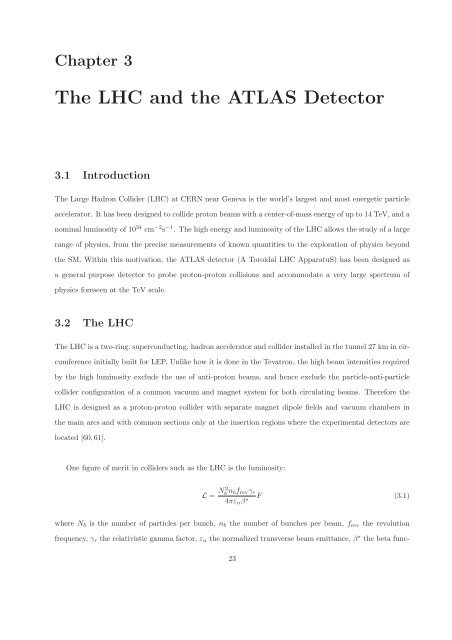CERN-THESIS-2012-153 26/07/2012 - CERN Document Server
CERN-THESIS-2012-153 26/07/2012 - CERN Document Server
CERN-THESIS-2012-153 26/07/2012 - CERN Document Server
You also want an ePaper? Increase the reach of your titles
YUMPU automatically turns print PDFs into web optimized ePapers that Google loves.
Chapter 3<br />
The LHC and the ATLAS Detector<br />
3.1 Introduction<br />
The Large Hadron Collider (LHC) at <strong>CERN</strong> near Geneva is the world’s largest and most energetic particle<br />
accelerator. It has been designed to collide proton beams with a center-of-mass energy of up to 14 TeV, and a<br />
nominal luminosity of 10 34 cm −2 s −1 . The high energy and luminosity of the LHC allows the study of a large<br />
range of physics, from the precise measurements of known quantities to the exploration of physics beyond<br />
the SM. Within this motivation, the ATLAS detector (A Toroidal LHC ApparatuS) has been designed as<br />
a general purpose detector to probe proton-proton collisions and accommodate a very large spectrum of<br />
physics foreseen at the TeV scale.<br />
3.2 The LHC<br />
The LHC is a two-ring, superconducting, hadron accelerator and collider installed in the tunnel 27 km in cir-<br />
cumference initially built for LEP. Unlike how it is done in the Tevatron, the high beam intensities required<br />
by the high luminosity exclude the use of anti-proton beams, and hence exclude the particle-anti-particle<br />
collider configuration of a common vacuum and magnet system for both circulating beams. Therefore the<br />
LHC is designed as a proton-proton collider with separate magnet dipole fields and vacuum chambers in<br />
the main arcs and with common sections only at the insertion regions where the experimental detectors are<br />
located [60,61].<br />
One figure of merit in colliders such as the LHC is the luminosity:<br />
L = N2 b nbfrevγr<br />
F (3.1)<br />
4πεnβ ∗<br />
where Nb is the number of particles per bunch, nb the number of bunches per beam, frev the revolution<br />
frequency, γr the relativistic gamma factor, εn the normalized transverse beam emittance, β ∗ the beta func-<br />
23















